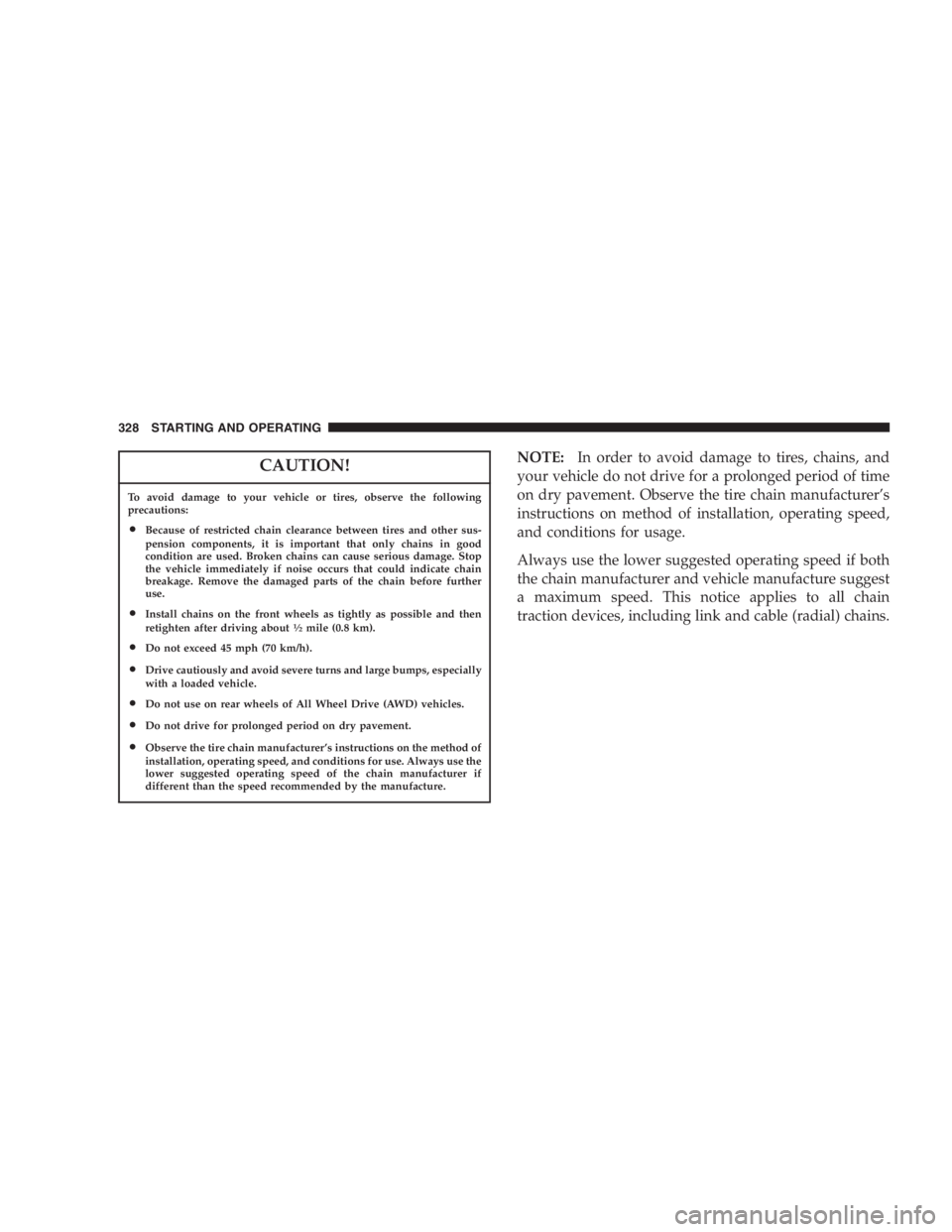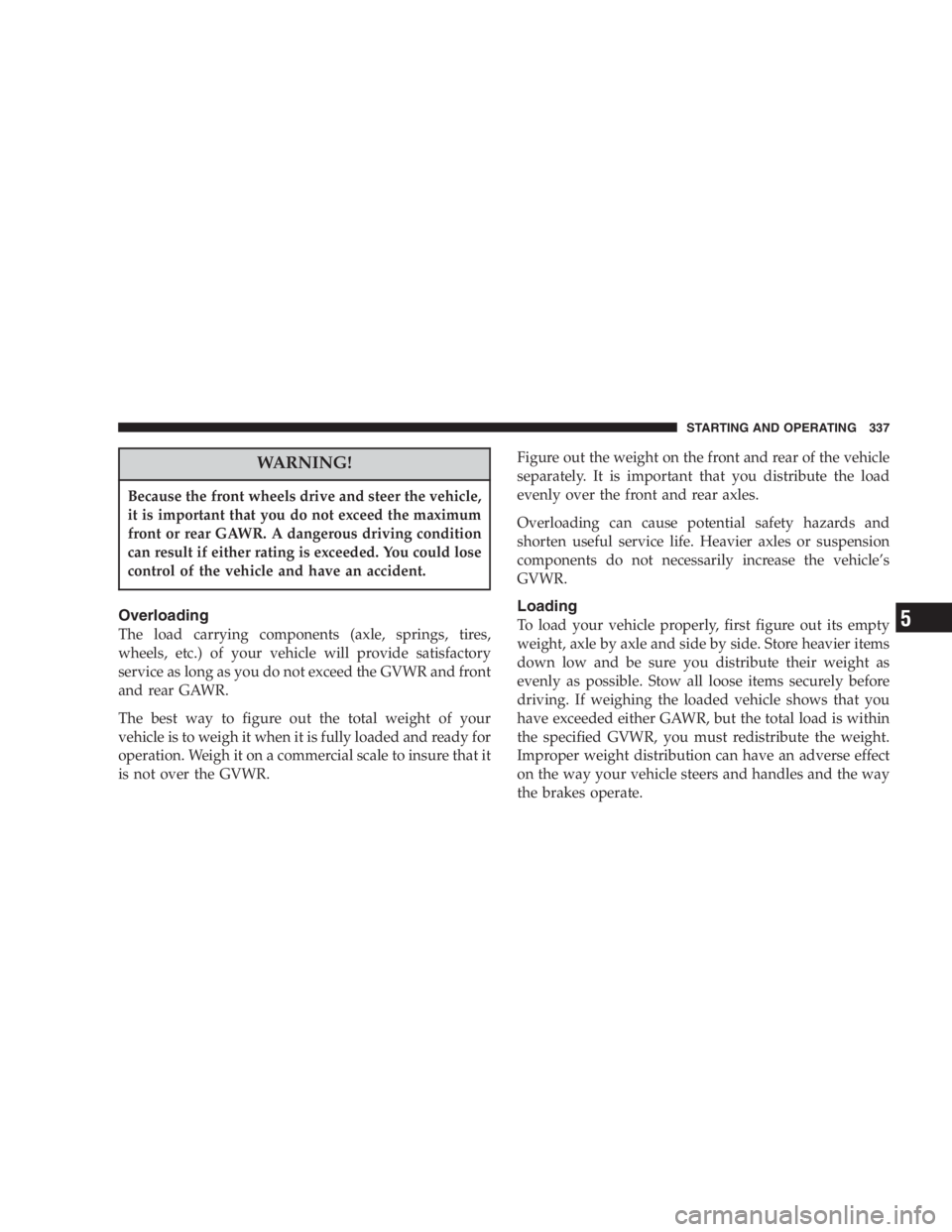Page 328 of 480

CAUTION!To avoid damage to your vehicle or tires, observe the following
precautions:
• Because of restricted chain clearance between tires and other sus-
pension components, it is important that only chains in good
condition are used. Broken chains can cause serious damage. Stop
the vehicle immediately if noise occurs that could indicate chain
breakage. Remove the damaged parts of the chain before further
use.
• Install chains on the front wheels as tightly as possible and then
retighten after driving about 1
⁄ 2
mile (0.8 km).
• Do not exceed 45 mph (70 km/h).
• Drive cautiously and avoid severe turns and large bumps, especially
with a loaded vehicle.
• Do not use on rear wheels of All Wheel Drive (AWD) vehicles.
• Do not drive for prolonged period on dry pavement.
• Observe the tire chain manufacturer ’ s instructions on the method of
installation, operating speed, and conditions for use. Always use the
lower suggested operating speed of the chain manufacturer if
different than the speed recommended by the manufacture. NOTE: In order to avoid damage to tires, chains, and
your vehicle do not drive for a prolonged period of time
on dry pavement. Observe the tire chain manufacturer ’ s
instructions on method of installation, operating speed,
and conditions for usage.
Always use the lower suggested operating speed if both
the chain manufacturer and vehicle manufacture suggest
a maximum speed. This notice applies to all chain
traction devices, including link and cable (radial) chains.328 STARTING AND OPERATING
Page 329 of 480

SNOW TIRES
Some areas of the country require the use of snow tires
during winter. Standard tires are of the all season type
and satisfy this requirement as indicated by the M+S
designation on the tire side wall.
If you need snow tires, select tires equivalent in size and
type to the original equipment tires. Use snow tires only
in sets of 4, failure to do so may adversely affect the
safety and handling of your vehicle.
Snow tires generally have lower speed ratings than what
was originally equipped with your vehicle and should
not be operated at sustained speeds over 75 mph (120
km/h). TIRE ROTATION RECOMMENDATIONS
Tires on the front and rear axles of vehicles operate at
different loads and perform different steering, driving,
and braking functions. For these reasons, they wear at
unequal rates, and tend to develop irregular wear pat-
terns.
These effects can be reduced by timely rotation of tires.
The benefits of rotation are especially worthwhile with
aggressive tread designs such as those on all season type
tires. Rotation will increase tread life, help to maintain
mud, snow, and wet traction levels, and contribute to a
smooth, quiet ride.
Follow the recommended tire rotation frequency for your
type of driving found in the “ Maintenance Schedules ”
Section of this manual. More frequent rotation is permis-
sible if desired. The reasons for any rapid or unusual
wear should be corrected prior to rotation being per-
formed. STARTING AND OPERATING 329
5
Page 337 of 480

WARNING!Because the front wheels drive and steer the vehicle,
it is important that you do not exceed the maximum
front or rear GAWR. A dangerous driving condition
can result if either rating is exceeded. You could lose
control of the vehicle and have an accident.
Overloading
The load carrying components (axle, springs, tires,
wheels, etc.) of your vehicle will provide satisfactory
service as long as you do not exceed the GVWR and front
and rear GAWR.
The best way to figure out the total weight of your
vehicle is to weigh it when it is fully loaded and ready for
operation. Weigh it on a commercial scale to insure that it
is not over the GVWR. Figure out the weight on the front and rear of the vehicle
separately. It is important that you distribute the load
evenly over the front and rear axles.
Overloading can cause potential safety hazards and
shorten useful service life. Heavier axles or suspension
components do not necessarily increase the vehicle ’ s
GVWR.
Loading
To load your vehicle properly, first figure out its empty
weight, axle by axle and side by side. Store heavier items
down low and be sure you distribute their weight as
evenly as possible. Stow all loose items securely before
driving. If weighing the loaded vehicle shows that you
have exceeded either GAWR, but the total load is within
the specified GVWR, you must redistribute the weight.
Improper weight distribution can have an adverse effect
on the way your vehicle steers and handles and the way
the brakes operate. STARTING AND OPERATING 337
5
Page 346 of 480

WARNING!A hot engine cooling system is dangerous. You or
others could be badly burned by steam or boiling
coolant. You may want to call a service center if your
vehicle overheats. If you decide to look under the
hood yourself, see Section 7, Maintenance, of this
manual. Follow the warnings under the Cooling
System Pressure Cap paragraph. JACKING AND TIRE CHANGING
WARNING!• Getting under a jacked-up vehicle is dangerous. The
vehicle could slip off the jack and fall on you. You
could be crushed. Never get any part of your body
under a vehicle that is on a jack. If you need to get
under a raised vehicle, take it to a service center
where it can be raised on a lift.
• The jack is designed to use as a tool for changing
tires only. The jack should not be used to lift the
vehicle for service purposes. The vehicle should be
jacked on a firm level surface only. Avoid ice or
slippery areas.
• For vehicles equipped with fold-in-floor seating, if it
is necessary to retrieve the spare tire from under the
vehicle on the side of the vehicle close to moving
traffic. Pull far enough off the road to avoid the
danger of being hit.346 WHAT TO DO IN EMERGENCIES
Page 368 of 480

2. Slow down if road has standing water or puddles.
3. Replace tires when tread wear indicators first become
visible.
4. Keep tires properly inflated.
5. Maintain sufficient distance between your vehicle and
the vehicle in front to avoid a collision in a sudden stop.
FREEING A STUCK VEHICLE
If your vehicle becomes stuck in mud, sand or snow, it
can often be moved by a rocking motion. Turn your
steering wheel right and left to clear the area around the
front wheels. Then shift back and forth between Reverse
and Drive. Usually the least accelerator pedal pressure to
maintain the rocking motion without spinning the
wheels is most effective. WARNING!Fast spinning tires can be dangerous. Forces gener-
ated by excessive wheel speeds may cause tire dam-
age or failure. A tire could explode and injure
someone. Do not spin your vehicle ’ s wheels faster
than 35 mph (55 km/h) when you are stuck. And
don ’ t let anyone near a spinning wheel, no matter
what the speed.
CAUTION!Racing the engine or spinning the wheels too fast
may lead to transmission overheating and failure. It
can also damage the tires. Do not spin the wheels
above 35 mph (55 km/h).368 WHAT TO DO IN EMERGENCIES
Page 430 of 480
Miles 3, 000 6, 000 9, 000 12, 000 15, 000 18, 000
(Kilometers) (5 000 ) (10 000 ) (14 000) (19 000) (24 000) (29 000)
Change engine oil and engine oil filter. XXXXX X
Rotate Tires X X X
Inspect the brake linings. X X
Inspect the engine air cleaner filter, replace if
necessary. * XXXX X
Replace the engine air cleaner filter. *X
Inspect and adjust the power steering pump
belt tension on 2.4 liter engines. X
Inspect the generator belt on 2.4 liter engines,
replace if necessary. X
Replace the air conditioning filter. X430 SCHEDULE “ B ”
8 M
A
I
N
T
E
N
A
N
C
E
S
C
H
E
D
U
L
E
S
Page 431 of 480
Miles 21, 000 24, 000 27, 000 30, 000 33, 000 36, 000
(Kilometers) (34 000) (38 000) (43 000) (48 000) (53 000) (58 000)
Change engine oil and engine oil filter. XXXXX X
Rotate Tires X X X
Inspect the brake linings. X X
Inspect the engine air cleaner filter, replace if
necessary. * XXX X X
Replace the engine air cleaner filter. X
Replace the spark plugs 2.4 liter engines. X
Inspect the tie rod ends and boot seals. X
Inspect and adjust the power steering pump
belt tension on 2.4 liter engines. X
Inspect the generator belt on 2.4 liter engines,
replace if necessary. X
Inspect the PCV valve and replace as neces-
sary.* X
Replace the air conditioning filter. X X SCHEDULE “ B ” 431
8 M
A
I
N
T
E
N
A
N
C
E
S
C
H
E
D
U
L
E
S
Page 432 of 480
Miles 39, 000 42, 000 45, 000 48, 000 51, 000 54, 000
(Kilometers) (62 000) (67 000) (72 000) (77 000) (82 000) (86 000)
Change engine oil and engine oil filter. XXXXX X
Rotate Tires X X X
Inspect the brake linings. X X
Inspect the engine air cleaner filter, replace if
necessary. * XX XX X
Replace the engine air cleaner filter. *X
Inspect and adjust the power steering pump
belt tension on 2.4 liter engines. X
Inspect the generator belt on 2.4 liter engines,
replace if necessary. X
Replace the air conditioning filter. X432 SCHEDULE “ B ”
8 M
A
I
N
T
E
N
A
N
C
E
S
C
H
E
D
U
L
E
S